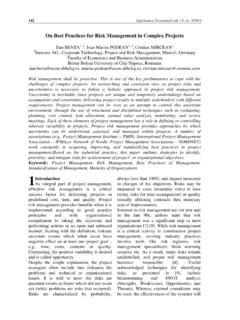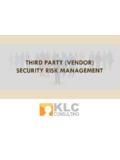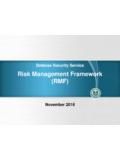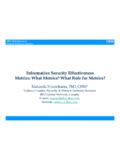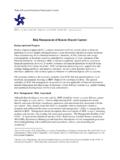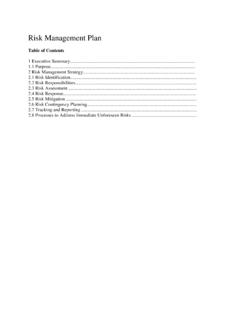Transcription of Security Risk Management - Approaches and Methodology
1 228 Informatica Economic vol. 15, no. 1/2011 Security Risk Management - Approaches and Methodology Elena Ramona STROIE, Alina Cristina RUSU Academy of Economic Studies, Bucharest, Romania In today s economic context, organizations are looking for ways to improve their business, to keep head of the competition and grow revenue. To stay competitive and consolidate their position on the market, the companies must use all the information they have and process their information for better support of their missions. For this reason managers have to take into consideration risks that can affect the organization and they have to minimize their impact on the organization.
2 Risk Management helps managers to better control the business practices and improve the business process. Keywords: Risk Management , Security , Methodology Introduction Today s economic context is characterized by a competitive environment which is permanently changing. To face this fierce competition, managers must take the correct strategic decisions based on real information. In order to maintain the authenticity and the accuracy of the information used in the decision process, any organization must use informatics systems to process their information and for a better support of their missions.
3 For this reason, the Management risk of the Security information plays a very important role in the organizational risk Management , because it assure the protection of the organization from the threatening information attacks, that could affect the business activity and therefore its missio n. An effective risk Management process is based on a successful IT Security program. This doesn t mean that the main goal of an organization s risk Management process is to protect its IT assets, but to protect the organization and its ability to perform their missions.
4 Therefore, the risk Management process should not be treated primarily as a technical function carried out by the IT experts, who operate and manage the IT system, but as an essential Management function of the organization and its leaders. [1] 2 Risk Management : definition and objectives The concept of the risk Management is applied in all aspects of business, including planning and project risk Management , health and safety, and finance. It is also a very common term amongst those concerned with IT Security .
5 A generic definition of risk Management is the assessment and mit igation of potential issues that are a threat to a business, whatever their source or origin. [2] The concept of risk Management is now fairly universally understood, having been in widespread use for a number of years. It is applied in all aspects of business. To discuss the definition of the risk Management is necessary to explain in advance the meaning of the three main concepts: Risk is the potential that a chosen action or activity (including the choice of inaction) will lead to a loss (an undesirable outcome).
6 Threat is the potential cause of an unwanted impact on a system or organization (ISO 13335-1). Threat can also be defined as an undesired event (intentional or unintentional) that may cause damage to the goods of the organization. Vulnerability is a weakness in system procedures, architectural system, its implementation, internal control and other causes that can be exploited to bypass Security systems and unauthorized access to information. Vulnerability represents any weakness, administrative process, act or 1 Informatica Economic vol.
7 15, no. 1/2011 229 statement that makes information about an asset to be capable of being exploited by a threat. Risk Management is a process consisting on: - identifying vulnerabilities and threats to the information resources used by an organization in achieving business objectives; -risk assessment by setting the probability and impact of its production, following threats by explo it ing vulnerabilities; - identify possible countermeasures and deciding which one could be applied, in order to reduce the risk to an acceptable level, based on the value of information resource to the organization.
8 [3] The goal of performing risk Management is to enable the organization to maintain at the highest values the activity results. This process should combine as efficient as possible, all factors which can increase the probability of success and decrease the uncertainty of achieving objectives. Risk Management should be an evolving process. Particular attention should be given to the implementation of the strategies for eliminating or reduce the risk and their appliance, to the analysis of the past evo lut ion of risks and to the present and future prediction of the events.
9 Management process should be implemented at the highest Management level. In IT&C, one of the most important goal of risk Management is to accomplish by better securing the informat ics systems that store, process, or transmit organizational information; by enabling Management to make well-informed risk Management decisio ns to justify the expenditures that are part of an IT budget and by assisting Management in authorizing (or accrediting) the IT systems, on the basis of the supporting documentation result ing fro m the performance of risk Management .
10 [1] 3 Risk Management Approaches : Proactive and reactive approach Risk Management can be approached in two ways: reactive and proactive. The reactive approach may be an effective response to the Security risks that have already occurred through creating Security incidents. The analysis of the causes of producing Security incidents could help the organization to prevent their repetition and be prepared for any possible problems. Companies that respond to Security incidents in a calm and rational way, meanwhile they determine the causes that have allowed the incidents to occur, will be able to respond in a shorter time to similar problems arising.
